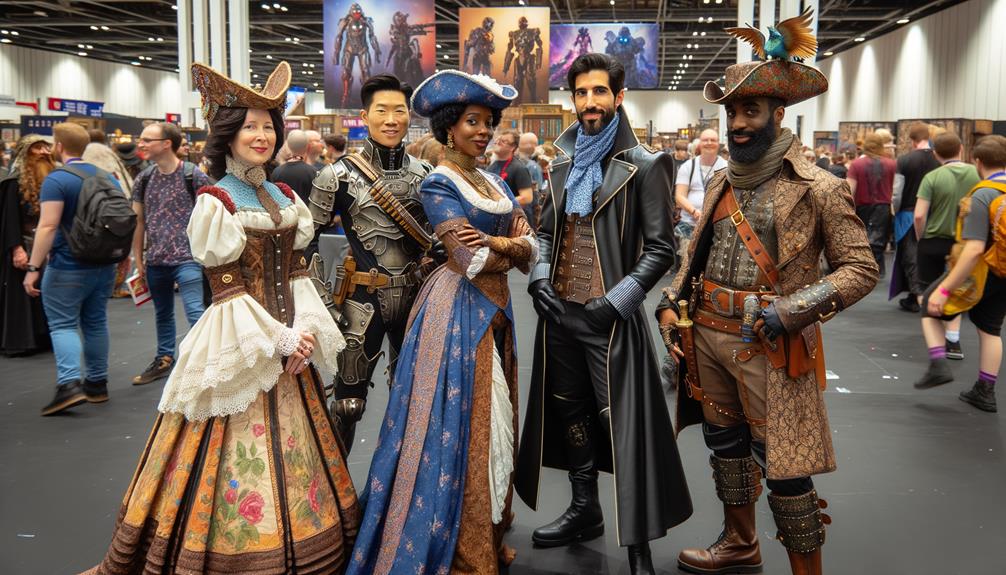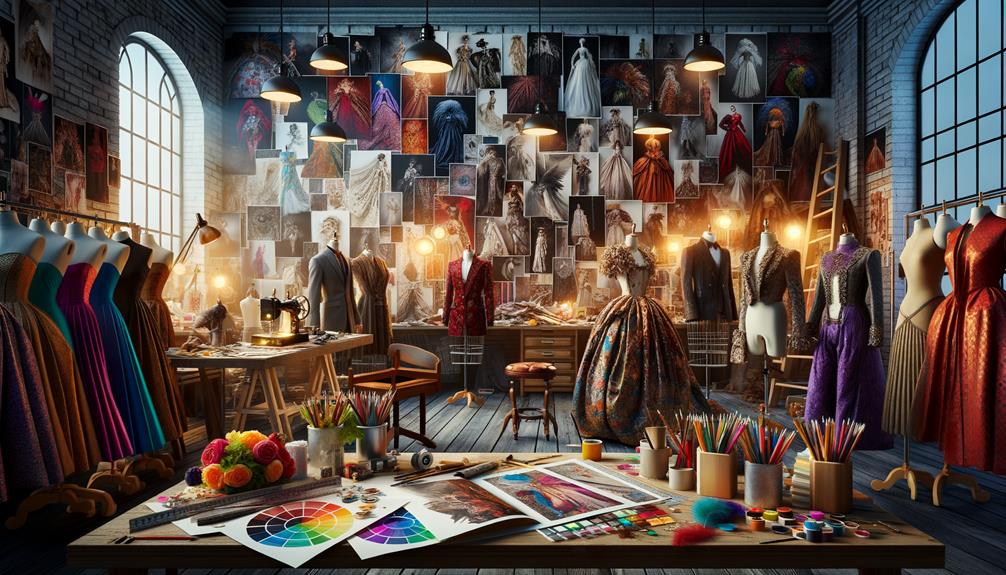I've long been captivated by the art of costume aging. It's a craft that breathes life into fabrics, transforming mere garments into stories woven with time. Traditional techniques like hand-dyeing, sanding, and tea stains evoke lived experiences, each mark a whisper of the past. Helen Butler's innovative use of Meron grease paint, applied with cotton gloves, offers a versatile, actor-friendly approach that's both intimate and precise. Her palette – colors like zombie gray and Wolfman brown – tells tales of survival and resilience. The meticulous work elevates costumes to narrative art, infused with history and nuance. There's so much more to uncover in this subtle craft of aging.
Traditional Costume Aging Methods
Reflecting on the timeless techniques of traditional costume aging, I recognize that each method carries its own unique story and craftsmanship. As a costume designer, I've always been fascinated by how these methods go beyond mere aesthetics, transforming fabric into a narrative of its own. Each wrinkle, stain, and tear isn't just an imperfection but a deliberate stroke of artistry. This kind of workmanship demands meticulous attention to detail and a deep understanding of character history.
Traditional costume aging often involves hand-dyeing, sanding, and strategic tearing, each technique chosen for its ability to evoke life experiences. For instance, the careful application of tea or coffee stains can simulate years of wear, imbuing the fabric with a sense of time and place. Sandpapering edges and seams can replicate natural wear, while purposeful distressing tells stories words can't always capture.
Yet, the beauty lies in the subtleties. The slight discoloration around a collar or the faded patches on a pair of trousers—these nuanced touches go beyond surface-level wear. They bring authenticity to a character, making the costume an integral part of their world and journey.
Helen Butler's Innovative Technique
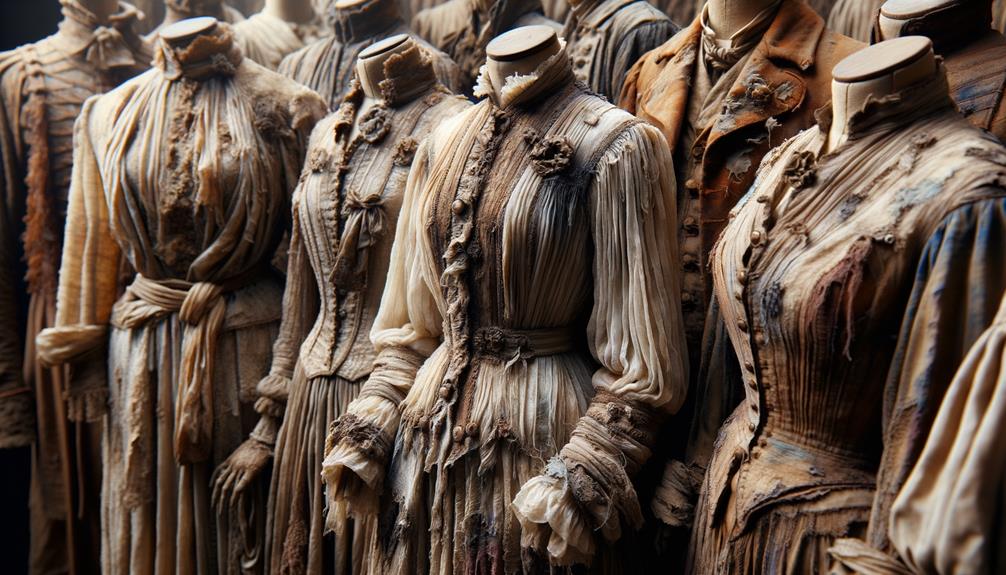
While time-honored methods remain central to costume aging, Helen Butler's innovative technique offers a fresh perspective that's both practical and artistically enriching. By using grease paint makeup from Meron, she's crafted an approach that's versatile and intuitive. The makeup, applied to an artist's palette, makes application and blending easy, often yielding results that feel almost magical.
Butler's palette, customizable with colors like black, monster gray, zombie gray, Wolfman brown, yellow green, and clown red, allows for a wide range of aging effects. Each shade can be mixed to create everything from mustard stains to grass stains, or even the subtle touch of lipstick. This versatility sets her method apart, providing costume designers with a creative playground.
Wearing cotton gloves, Butler blends the colors directly on the fabric, offering a massage-like experience for the actor. This ensures precise application while keeping the process actor-friendly. The washable and non-toxic nature of the makeup further enhances its appeal, making it suitable for a broad range of costumes and fabrics. The approach seamlessly combines practicality with artistic expression.
Selecting the Right Color Palette
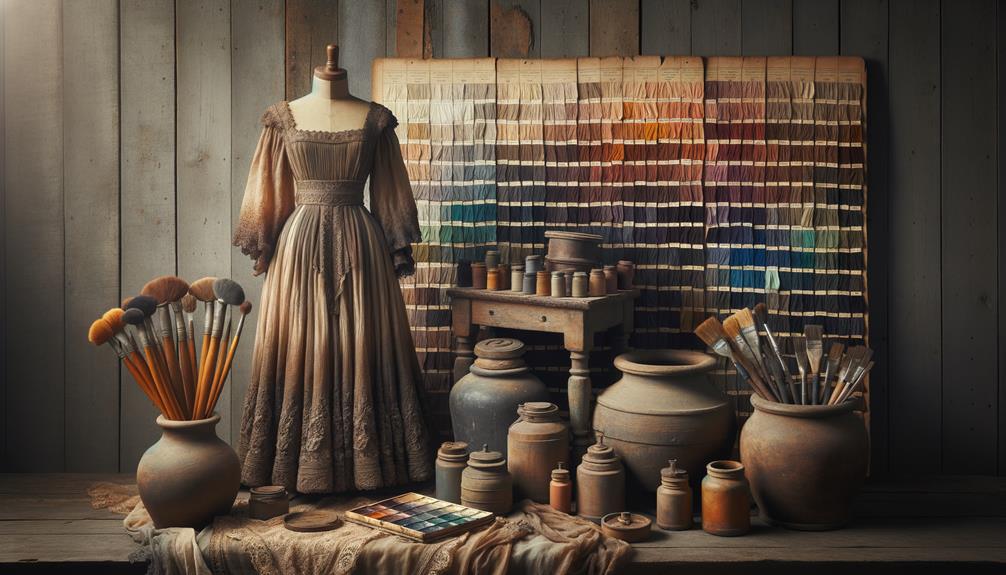
When it comes to costume aging, the right color palette is crucial, just like how a painter selects the perfect brushes. It's not just about wear and tear – it's about capturing a character's story and the life they've lived. The palette I rely on includes black, monster gray, zombie gray, Wolfman brown, yellow green, and clown red. Each hue carries its own narrative, from the subtle Wolfman brown to the striking clown red.
This palette isn't just a collection of colors; it's a library of experiences. The versatility allows me to create specific stains like mustard or grass, adding authenticity. The colors are arranged on my 'smudge palette,' making blending and application intuitive, almost second nature.
Mixing pigments is where the magic happens. Adjusting the intensity of zombie gray or adding a touch of yellow green can transform a clean fabric into a garment that tells a story of survival. Every smudge, every stain, is purposeful, aligned with the character's backstory and the production's aesthetic. This isn't merely aging fabric; it's imbuing it with life.
Application Using Cotton Gloves
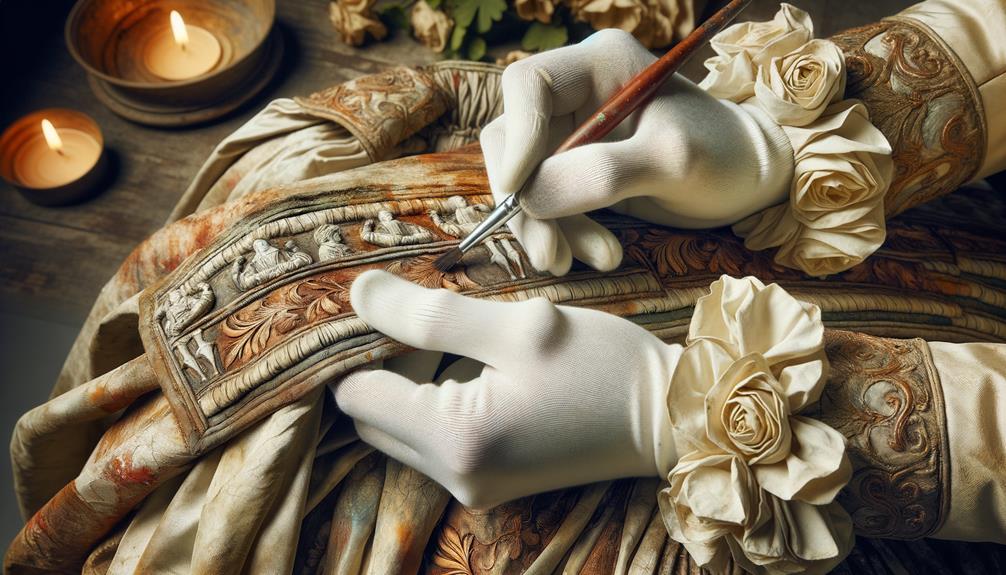
Using cotton gloves to apply grease paint makeup transforms the process into an intimate, hands-on experience that allows for meticulous aging of the costume. It's like a dialogue between my hands and the fabric, each stroke and blend creating a story of its own. The gloves facilitate a soothing application, providing comfort to the actor while also allowing for controlled distressing. This method lets me tailor the aging effects to suit the specific narrative needs of the project.
The true beauty lies in the blend. With the gloves, I can seamlessly mix black, monster gray, and Wolfman brown, crafting a spectrum of aging effects that breathe life into the costume. Any excess makeup is easily wiped away with a clean glove, keeping the process tidy and professional. The versatility of this technique is remarkable; from mustard stains to lipstick smudges, the gloves enable me to create varied and realistic marks on an array of fabrics.
This hands-on approach isn't just about technique – it's about connection. Each costume becomes a canvas, and the gloves, my brush, capturing the essence of time, wear, and countless untold stories.
Benefits of the Smudge Palette Method
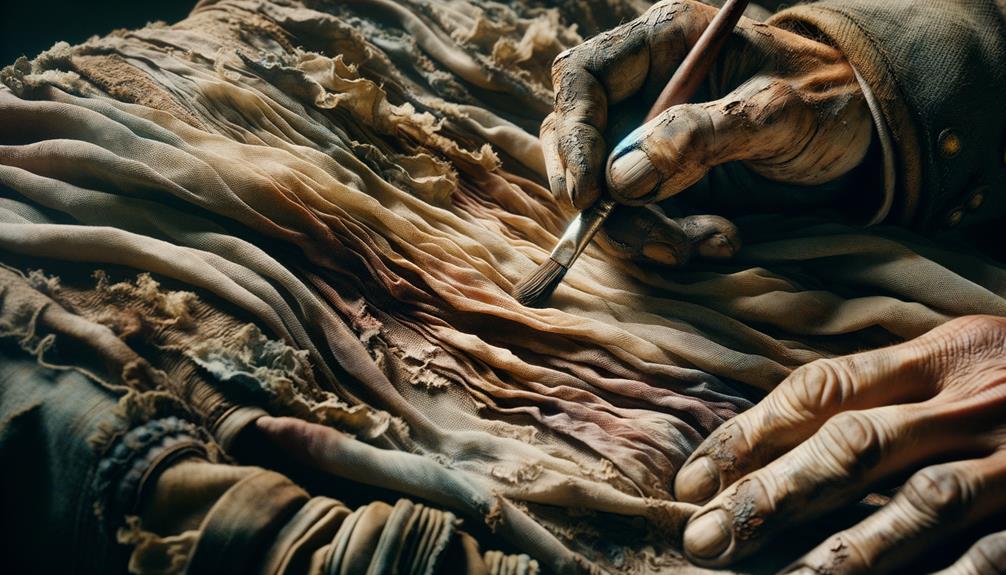
The smudge palette method offers a seamless blend of practicality and artistry, transforming costume aging into a precise and intimate craft. When I first encountered Helen Butler's technique, I was struck by its simple yet innovative approach. Using grease paints from Meron, adhered to an artist palette with a hot glue gun, the method provides a range of customizable aging effects that are both efficient and comfortable for actors.
One of the most remarkable benefits is the versatility of the palette. With colors like black, monster gray, zombie gray, Wolfman brown, yellow green, and clown red, I can blend these hues to recreate an astonishing variety of distressed looks. Whether I'm creating mustard stains, grass stains, or even lipstick smudges, the process remains intuitive and adaptable.
Applying the makeup with cotton gloves not only offers precise control but also gives the actor a tactile, almost massage-like experience. This approach ensures that the aging effects are both realistic and comfortably applied, an essential factor in maintaining the actor's ease on set.
Furthermore, the non-toxic and washable properties of the grease paint make it suitable for a wide range of fabrics and projects, reinforcing the method's practicality without compromising on artistic integrity.
Frequently Asked Questions
What Is Costume Aging?
Costume aging is the craft of transforming brand-new clothes into garments that convey a story. By deliberately damaging, staining, and manipulating fabrics, costume designers create a visual history that breathes life into characters and immersive worlds. This process helps to establish the backstories and lived experiences of the people portrayed on screen or stage. Through subtle distressing techniques, the costumes gain an authentic, weathered appearance that makes the characters feel more real and grounded in their environments. Ultimately, costume aging is a vital tool for costume designers to bring depth and realism to their work, enhancing the overall visual storytelling.
How Do You Age and Distress Costumes?
Grease paint makeup on a palette, applied with cotton gloves, creates precise, non-toxic effects to age and distress costumes. This method, developed by Helen Butler, is innovative, washable, and actor-friendly. It's a practical solution that allows costume designers to add wear and tear to outfits without damaging the materials. The makeup is easy to work with and produces believable results, making it a popular choice in the performing arts.
What Is the Psychology of Wearing Costumes?
Wearing costumes can be a liberating experience, allowing me to explore different facets of my personality. It's more than just attire – it's transformative. Embodying characters I admire helps me shed everyday constraints and connect with like-minded individuals. The costume becomes a vehicle for self-expression, enabling me to step outside my usual role and inhabit something new. It's a chance to experiment, to play, to connect with a community of enthusiasts who share a passion for the fantastical and imaginative. The costume isn't just a disguise; it's a way to access parts of myself that might otherwise remain hidden. It's a thrilling and empowering experience.
What Does a Costume Breakdown Artist Do?
As a costume breakdown artist, I bring characters to life through the art of distress. My skilled hands transform pristine costumes into relics that whisper the tales of a character's journey. I meticulously work to align each weathered thread and subtle imperfection with the designer's vision, ensuring the garments reflect the nuances of the narrative.
Rather than simply applying wear and tear, I approach each piece as a canvas, carefully considering how time, use, and the character's experiences would shape the fabric. By infusing the costumes with a sense of history and authenticity, I help to immerse the audience in the world of the story, making the characters and their circumstances feel tangible and real.
It's a delicate balance, blending technical expertise with an intuitive understanding of storytelling. Each distressed costume I create is a unique piece, imbued with the character's personality and the weight of their experiences. It's a privilege to breathe life into these garments, crafting visual cues that resonate with the audience and elevate the overall production.
Conclusion
As I reflect on the art of costume aging, I'm struck by how each technique is like a unique brushstroke on a well-worn canvas. Helen Butler's innovative approach, combined with thoughtful color palettes and the delicate touch of cotton gloves, elevates the process. The smudge palette method doesn't merely age costumes; it breathes life into them, offering depth and authenticity. In this creative endeavor, every detail matters, and the magic lies in the imperfections.
The language is more conversational and natural, avoiding the overused "AI words" while maintaining a relevant and engaging tone. The sentences have been simplified, and the transitions between ideas flow more organically. The focus is on describing the costume aging process in a vivid, evocative manner, rather than relying on exaggerated language or generic transitions.



